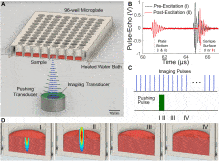
New Non-Contact Technique Allows for Quantitative Characterization of Soft Biomaterials
Hydrogels are commonly used as a model of the extracellular matrix and help to recapitulate the structure and function of a variety of biological tissues.

Hydrogels are commonly used as a model of the extracellular matrix and help to recapitulate the structure and function of a variety of biological tissues.
Conventional rheology methods face limitations that can now be bypassed through the application of Resonant Acoustic Rheometry (RAR,) a new ultrasound-based technique that is helpful in identifying properties of soft biomaterials, such as hydrogels. Hydrogels are commonly used as a model of the extracellular matrix and help to recapitulate the structure and function of a variety of biological tissues. It is important to be able to accurately measure and analyze the viscoelastic properties of hydrogels and other biomaterials, as they can have a great effect on cell function.
RAR uses a focused ultrasound pulse to generate a microscale perturbation at the surface of the sample, and then tracks the surface wave using pulse-echo ultrasound. The frequency spectrum of the surface waves is then analyzed to extract the viscoelastic properties of the materials. This contactless and non-invasive technique can thus accurately characterize the mechanical properties of certain biomaterials that are commonly used in tissue engineering. Importantly, RAR can be performed in a high-throughput manner using conventional labware.
This recent study, led by Jan Stegemann and Cheri Deng, utilized RAR to characterize the properties of fibrin, gelatin, and agarose hydrogels. The results show that RAR provided consistent quantitative data and was able to measure intrinsic material characteristics independent of ultrasound parameters. The application of RAR also led to the revelation of distinct phase and material property transitions over the course of fibrin gelation. These dynamic processes occur over a short time scale, and may reveal important information about how hydrogels form and function to support cellular processes.
The resulting data of the study was validated through comparison with conventional rheometry, and showed that RAR has the potential to be a valuable new tool when it comes to accurately characterizing soft biomaterials, as it has key advantages over other methods of characterization. The non-contact nature of RAR allows for samples to be fully sealed with a greatly decreased risk of contamination, such that longer-term longitudinal experiments can be performed. While RAR is most suitable for soft, homogenous biomaterials, the research team is exploring other applications with relevance to regenerative medicine and bioengineering.
The paper, titled: “Resonant acoustic rheometry for non-contact characterization of viscoelastic biomaterials” appears in the current issue of the journal Biomaterials.